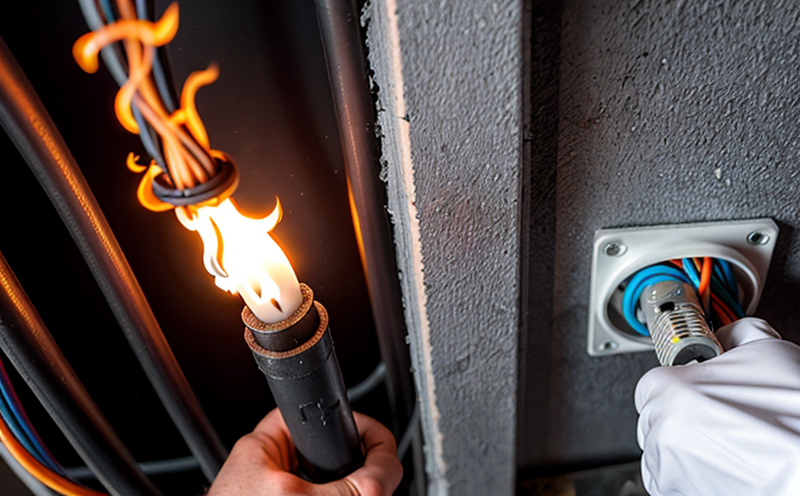Fire Behavior Testing of Single-Core Cables
The fire behavior testing of single-core cables is a critical aspect of ensuring safety and compliance in various sectors, including construction, infrastructure, and industrial facilities. This testing evaluates the flame spread characteristics and heat release rate of single-core cables under specified conditions. The results provide essential data for assessing the fire risk associated with these materials.
Single-core cables are widely used across numerous applications due to their flexibility and ease of installation. However, they must meet stringent safety standards to ensure that they do not contribute significantly to a potential fire hazard. This testing involves subjecting the cable specimens to controlled conditions in a laboratory environment where flame is applied, and then measuring various parameters such as smoke production, heat release rate, and the distance traveled by flames along the cable.
The test procedure typically follows international standards like ISO 13943 or ASTM E84. These standards define specific methods for conducting the tests and interpreting the results. Compliance with these standards is essential to ensure that the testing process is standardized, reproducible, and reliable. The apparatus used in this testing includes a cone calorimeter for measuring heat release rate and a smoke chamber for quantifying smoke production.
Specimen preparation is critical for accurate test results. Prior to testing, single-core cables are cut into standard lengths and diameters as specified by the relevant standards. This ensures that each specimen presents similar surface area-to-volume ratios, which is crucial for consistent measurement of fire behavior parameters.
The testing process involves subjecting the prepared specimens to a flame source for a specified duration, typically 10 minutes. During this period, various measurements are taken using specialized instruments. These include the rate at which flames spread along the cable, the temperature rise at different points on the specimen, and the amount of smoke produced.
| Test Parameter | Instrumentation |
|---|---|
| Flame Spread Index (FSI) | Cone Calorimeter |
| Heat Release Rate (HRR) | Cone Calorimeter |
| Smoke Production | Smoke Chamber |
| Temperature Rise | Infrared Thermometer |
The results of these tests provide valuable insights into the fire behavior characteristics of single-core cables. These data are used to assess the likelihood of a cable igniting and spreading flames, as well as the amount of smoke and heat it generates during combustion. This information is crucial for ensuring that cables meet safety standards and do not contribute unduly to the severity of potential fires.
Understanding these parameters helps in selecting appropriate materials and designs for critical applications where fire safety is paramount. For instance, in underground installations or areas with limited evacuation routes, the ability to control flame spread and minimize smoke generation becomes even more crucial.
Why It Matters
The importance of fire behavior testing cannot be overstated, especially for single-core cables used in high-risk environments. In such settings, the potential impact of a fire can be catastrophic, affecting not only property but also human life and safety.
- Reduces Fire Risk: By understanding how cables behave under fire conditions, manufacturers can design safer products that do not exacerbate the situation in case of ignition.
- Enhances Compliance: Adherence to international standards ensures consistent quality and reliability, which is essential for meeting regulatory requirements.
- Promotes Safety: Accurate testing helps identify potential hazards early on, allowing manufacturers to take corrective actions before products reach the market.
In summary, fire behavior testing of single-core cables plays a vital role in enhancing safety and compliance across various sectors. It provides critical data that informs design choices and ensures that cables contribute positively to overall fire safety measures.
International Acceptance and Recognition
- ISO Standard ISO 13943: This standard provides a framework for testing the smoke production characteristics of building materials, including single-core cables.
- ASTM E84: Known as the "Smoking Tunnel Test," this method evaluates flame spread and smoke development indices.
The acceptance and recognition of these standards are crucial for ensuring that fire behavior testing is conducted consistently across different countries and regions. Laboratories accredited to perform these tests use internationally recognized methodologies, which enhances credibility and reliability in the results produced.
Use Cases and Application Examples
- Critical Infrastructure: Fire behavior testing is essential for cables used in power substations, data centers, and other critical infrastructure where downtime can be costly.
- Construction Projects: In buildings with high occupancy rates or complex layouts, the fire resistance of single-core cables is crucial to minimize damage during a fire event.
The following use cases highlight specific applications where fire behavior testing of single-core cables is particularly important:
| Use Case | Application Example |
|---|---|
| Critical Infrastructure | Power substations and data centers |
| Construction Projects | Broadband and telecommunications facilities |
| Retail Spaces | Shopping malls and large commercial buildings |
| Hospital Facilities | Nursing homes and hospitals with extensive cabling systems |





